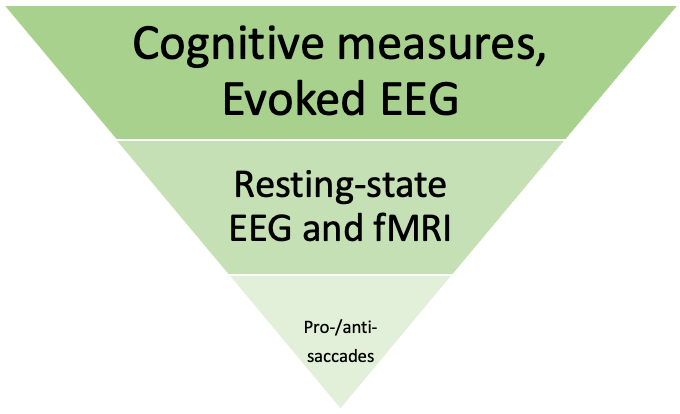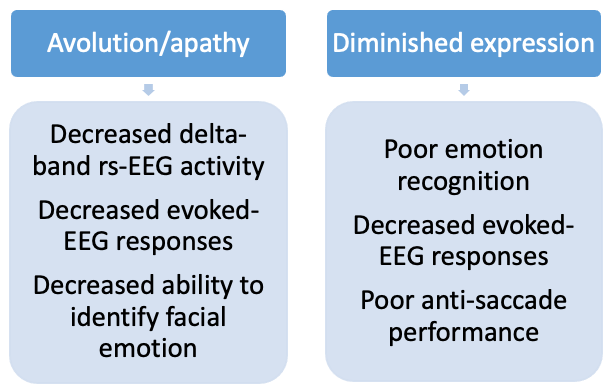
Biomarker Signature of Negative Symptoms
- Negative symptoms (NS) can be associated with behavioural and brain-based biomarkers.
- The biomarker modalities most strongly associated with negative symptoms were cognitive measures and evoked electroencephalography (EEG), followed by resting-state EEG and functional magnetic resonance imaging (fMRI), as well as pro-/anti-saccades.
- A full spectrum of symptoms cannot be adequately captured by one biomarker/biomarker modality.
In this section
This article by Hudgens-Haney et al. investigated whether negative symptoms (NS) can be associated with behavioural and brain-based biomarkers. The study examined 932 patients with psychosis from the Bipolar-Schizophrenia Network for Intermediate Phenotypes-1 (B-SNIP1) database. The article (1) identified individual biomarkers that separate B-SNIP1 probands with predominant NS from those without; (2) describes complex relationships between NS and a broad biomarker battery; and (3) demonstrates that distinct biomarker profiles characterise two widely accepted domains of NS: “avolition/apathy” (including avolition and anhedonia) versus “diminished expression” (including blunted effect and alogia).
An extensive B-SNIP phenotyping battery was collected on each participant: Associations between PANSS-defined NS and (1) cognition, (2) pro-/anti-saccades, (3) evoked and resting-state electroencephalography (EEG), (4) resting-state fMRI, and (5) tractography were measured in the study and were identified as symptom-biomarker relationships.
Probands divided into subgroups of NS and non-NS.
The study identified specific biomarkers differentiating patients with predominant NS from those without.
These were differentiated only by cognition and suggest that NS potentially shares a fairly direct relationship with cognitive impairment in psychosis. Emotion recognition, BACS (Brief Assessment of Cognition in Schizophrenia), and the working memory span backward score were the only individual biomarkers that significantly differentiated NS from non-NS. This suggests a relatively direct relationship between overall NS severity and cognitive impairment, but the associations had weak correlations which suggests that NS cannot be fully explained solely by poor cognition.
NS and neurobiological characteristics of brain function
The study examined the association between NS and various neurobiological characteristics of brain function. NS across all psychosis probands were found to have a strong association with low cognitive ability and aberrant neurophysiology. Sensory and information processing were “potential distinguishing alterations for NS”. The biomarker modalities most associated with negative symptoms can be seen in Figure 1.
Figure 1: The biomarker modalities most strongly associated with negative symptoms (from most to least, descending). The importance of both sensory and information processing constructs for understanding negative symptoms is emphasised from the most important to the least important in descending order.
Data from the study shows that individual NS items “captured unique biomarker variance”, and therefore showed that NS are complex neurobiologically and that the individual NS constructs are distinct and informative.
Biomarker profiles and the two domains of NS
The consensus in the literature has been that NS can be grouped into two domains: 1) Avolition/apathy (including avolition and anhedonia) and 2) diminished expression (including blunted effect and alogia). This study also supports two separate NS domains, which were characterised by distinct biomarker profiles, as illustrated by Figure 2.
Figure 2: Two separate negative symptom domains, characterised by distinct biomarker profiles (adapted from article text).
These findings suggest that it is not an isolated biomarker that is required to fully characterise the biological characteristics of NS, but rather a battery of biomarkers, which can be seen in Figure 2.
In patients with greater symptoms severity in the “diminished expression” domain, there was an association with lower evoked-EEG amplitude, lower cognitive performance, increased frontoparietal resting state (rs)-fMRI activity, and poor anti-saccade performance. In a follow-up analysis, low cognitive performance, low evoked-EEG amplitudes, and deviant frontoparietal rs-fMRI were identified as a biosignature of NS.
On the other hand, there was an inconsistent relationship between NS in the “avolition/apathy” domain regarding their association with various biomarker modalities. This further illustrates that a full spectrum of symptoms cannot be adequately captured by one biomarker/biomarker modality. It is therefore important to add the different biomarker modalities presented in the study to determine the latent structure of NS, rather than just continue using only symptom scale information, in order not to miss important clinically relevant neurobiological information. Characterising a neurobiologically complex clinical construct such as NS can be aided using the extensive biomarker batteries presented in the study.
The study findings may have found a biosignature for the presence of NS consisting of cognitive impairment, low evoked-EEG amplitude, slow saccades, and deviant resting-state activity. The study’s authors also concluded that “while the “diminished expression” and “avolition/apathy” domains revealed distinct and condensed biomarker
profiles, much more symptom variance was explained in those analyses which included NS as a complex
set rather than as a summary score, highlighting the importance of multilevel integration of biomarker and clinical
batteries.”
Schizophrenia Bulletin
Cognitive Impairment and Diminished Neural Responses Constitute a Biomarker
Signature of Negative Symptoms in Psychosis
doi:10.1093/schbul/sbaa001
NEGATIVE SYMPTOMS – THE CHALLENGE
Although negative symptoms have long been recognized as an independent symptom domain, distinct from positive symptoms, neurocognition, and social cognition, th
more…PATIENT WITH EARLY PSYCHOSIS
This article by D. De Berardis et al. summarizes a case report of early schizophrenia treated successfully with our product monotherapy.
more…




